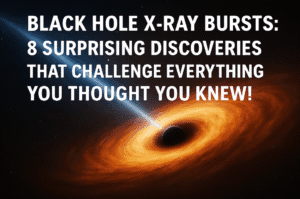Black Hole X-Ray Bursts: 8 Surprising Discoveries That Challenge Everything You Thought You Knew!
A 15-year study of eight ultra-luminous X-ray sources (ULXs), led by Seshadri Majumder and colleagues, has uncovered surprising patterns in how black holes interact with their surrounding matter. The research revealed both anti-correlations and one unusual positive correlation between disc luminosity and temperature. Most ULXs showed a trend where brighter discs cooled as they emitted more energy, aligning with slim disc models.
However, NGC5204 X−1 was an outlier, showing a positive correlation, indicating a potential transition between disc types. The study also highlighted varied spectral states, with some ULXs showing harder X-ray spectra due to Comptonization and others exhibiting softer, disc-dominated spectra. Additionally, a quasi-periodic oscillation detected in NGC55 ULX1 offers new insights into the behavior of matter near black holes. These findings challenge existing models of black hole accretion and provide valuable data for future space observatories.

Black Hole X-Ray Bursts: 8 Surprising Discoveries That Challenge Everything You Thought You Knew!
A groundbreaking 15-year study of eight ultra-luminous X-ray sources (ULXs)—extremely bright objects thought to involve black holes—has revealed surprising relationships between their brightness and temperature, challenging conventional models of how matter behaves near these cosmic giants. Published in Monthly Notices of the Royal Astronomical Society, the research led by Seshadri Majumder, Santabrata Das, and Anuj Nandi analyzed data from the XMM-Newton space observatory, uncovering a mix of anti-correlations and one unusual positive link between disc luminosity (Ldisc) and temperature (Tcol).
ULXs: Cosmic Powerhouses with a Secret
ULXs are enigmatic objects that emit up to millions of times more X-rays than the Sun. While many are suspected to involve stellar-mass black holes feeding on material at extraordinary rates, their extreme brightness and variability have long puzzled astronomers. This study focused on eight ULXs, including NGC1313 X−1 and NGC5204 X−1, to decode how their accretion discs—the swirling matter spiraling into black holes—interact with surrounding coronae (hot, energetic particle clouds).
Key Findings: A Tale of Two Correlations
By modeling X-ray spectra, the team identified two distinct behaviors:
- Anti-Correlation Dominance: Six sources, like NGC5408 X−1 and IC342 X−1, showed a decline in disc temperature as luminosity increased. This trend, following a power-law relation Ldisc ∝ Tcol^α, had exponents ranging from α = −3.58 to −10.31, suggesting that brighter discs paradoxically cool as they feed more material. This aligns with predictions of “slim disc” models, where radiation is trapped in dense, fast-moving accretion flows.
- The Outlier: NGC5204 X−1 defied the norm with a positive correlation (α = 1.4), where temperature rose alongside luminosity. This hints at a rare transition from a “standard” accretion disc (where energy radiates efficiently) to a “slim” disc, offering a real-time glimpse into how black holes manage extreme feeding rates.
Spectral States and the Role of Coronae
The ULXs also exhibited varied spectral states:
- Harder States: Four sources, including NGC1313 X−1, showed dominant Comptonization—a process where cooler disc photons gain energy by colliding with hot corona electrons. Their spectra were harder (Γ ≲ 2) and less disc-dominated.
- Softer States: NGC6946 X−1 and NGC55 ULX1 remained disc-dominated, with softer spectra (Γ ≳ 2), implying stable accretion.
- Intermediate Behavior: NGC5408 X−1 bridged these states, highlighting the dynamic interplay between disc, corona, and possible outflows.
Discovery of a Quasi-Periodic Oscillation (QPO)
In a first for NGC55 ULX1, researchers detected a QPO—a faint, rhythmic X-ray flicker—at ~20 millihertz. With 6.6% variability and a “quality factor” of ~6.7, this signal may trace clumps of matter orbiting near the black hole’s event horizon, offering clues to the object’s magnetic fields or spin.
Why This Matters
The study’s lead authors emphasize that these findings advance our understanding of accretion physics under extreme conditions. “The anti-correlations suggest radiation pressure and advection dominate in slim discs, while the lone positive correlation in NGC5204 X−1 could mark a pivotal transition phase,” they note. Such insights refine models of how black holes grow and influence their galaxies through winds and jets.
Looking Ahead
Future missions like ESA’s Athena X-ray observatory could probe these ULXs in greater detail, testing whether their spectral states depend on viewing angle or intrinsic physics. For now, this decade-long dataset underscores the diversity of black hole feeding mechanisms—and the universe’s knack for defying expectations.
You must be logged in to post a comment.